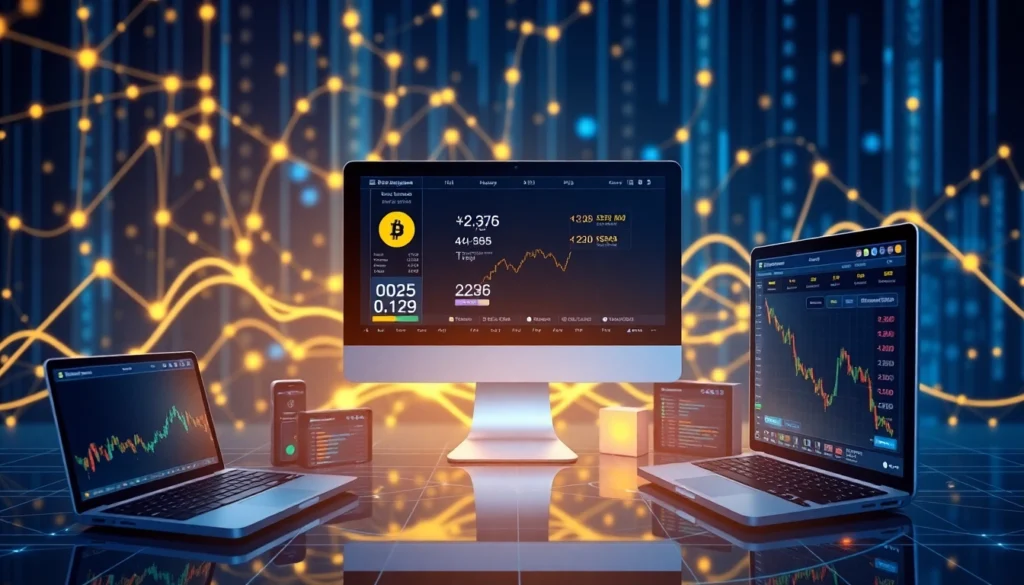How to Choose the Right Crypto Exchange for Seamless Digital Trading Success

Understanding the Basics of a Crypto Exchange
In the rapidly evolving landscape of digital assets, a crypto exchange serves as the critical hub where traders, investors, and institutions buy, sell, and trade cryptocurrencies. Fundamentally, a crypto exchange functions analogous to a traditional stock market, but it is tailored to digital currencies such as Bitcoin, Ethereum, and an array of altcoins. These platforms facilitate the transfer of assets between users, executing trades based on real-time price discovery mechanisms.
Crypto exchanges operate through various models, including order matching systems that pair buy and sell orders, and they often provide features like wallet services, market analytics, and advanced trading tools. They also enable liquidity provision via market makers and arbitrage opportunities, contributing to efficient markets and fair pricing. The core operation involves a combination of secure transaction processing, asset custody, and compliance measures to ensure integrity and trust within the ecosystem.
Types of Crypto Exchanges: Centralized vs Decentralized
When selecting a crypto exchange, understanding the distinction between centralized and decentralized exchanges is paramount. Centralized exchanges (CEXs) are operated by a third-party entity that manages user accounts, conducts security checks, and facilitates seamless trading. They typically offer superior liquidity, faster transaction execution, and a user-friendly interface, making them suitable for beginners and institutional traders alike. Notable examples include Binance, Coinbase, and Crypto.com, which are known for their reliability and extensive asset offerings.
Conversely, decentralized exchanges (DEXs) operate without a central authority, leveraging blockchain technology to enable peer-to-peer trading. Users retain control over their private keys, enhancing security and privacy. DEXs employ smart contracts to facilitate trades and often support innovative features like token swaps and liquidity pools. Platforms such as Uniswap and SushiSwap exemplify this model, catering to traders seeking greater autonomy and reduced counterparty risk.
Each type has its advantages and challenges; CEXs are often more accessible but carry higher scrutiny regarding security and regulations, while DEXs prioritize privacy but may experience lower liquidity and higher complexity for newcomers.
Key Features to Look for in a Reliable Crypto Exchange
Selecting a reliable crypto exchange involves evaluating several critical features to ensure a secure and functional trading environment. Security measures such as two-factor authentication (2FA), cold storage for assets, and anti-phishing protocols are essential to safeguard your digital holdings.
An intuitive user interface combined with robust trading tools enhances user experience and efficiency. Advanced traders benefit from features like limit and stop-loss orders, margin trading, and real-time analytics. Liquidity depth ensures that large transactions do not significantly impact market prices, facilitating smoother trading.
Also, consider the variety of supported cryptocurrencies, fiat-to-crypto gateways, and the flexibility of API integration for automated strategies. Transparent fee structures, responsive customer support, and a clear compliance record contribute to the overall dependability of the platform.
Evaluating Security and Compliance
Security Protocols and Measures in Crypto Platforms
Security is non-negotiable in crypto trading. Leading exchanges implement multi-layered defense systems, including encryption, cold storage for the majority of funds, and continuous security audits. Incorporating technologies like biometric authentication and hardware security modules further enhances protection against hacking.
Regulatory Compliance and Legal Considerations
Regulatory landscapes vary worldwide, affecting exchange operations and user protections. Reputable platforms adhere to Know Your Customer (KYC) and Anti-Money Laundering (AML) policies, ensuring compliance with local laws and fostering trust among users. Staying informed about legal developments is crucial for traders to avoid potential risks or account freezes.
Tips to Protect Your Digital Assets on Crypto Exchanges
To maximize security, enable two-factor authentication, use strong and unique passwords, and consider withdrawing assets to personal cold wallets for long-term holdings. Regularly monitor account activity and implement alerts for suspicious transactions. Educating oneself on common scams, such as phishing or fake tokens, can prevent unwarranted losses.
Trading Features and User Experience
Advanced Trading Tools and Analytics
Top-tier exchanges provide sophisticated tools like real-time candlestick charts, depth of market views, and customizable indicators. These features enable traders to execute technical analysis and develop strategic entry and exit points. Some platforms also offer paper trading accounts for practice without risking real assets.
Mobile Accessibility and User Interface Design
Given the 24/7 nature of crypto markets, mobile trading apps are indispensable. Leading platforms focus on clean, responsive design, ensuring seamless navigation and quick execution across devices. Multi-language support and user customization options further enhance accessibility for diverse user bases.
Order Types and Liquidity Options for Traders
Flexibility in order types—market, limit, stop-limit, take-profit—allows traders to implement complex strategies. Deep liquidity pools are essential for executing large orders without significant slippage, maintaining price stability during high-volume trading sessions.
Fee Structures, Support, and Customer Service
Understanding Trading Fees and Withdrawal Limits
Transparent fee structures—maker/taker fees, deposit/withdrawal charges—are vital to assessing overall profitability. Some exchanges offer discounted rates for high-volume traders or native tokens that reduce transaction costs. Always verify withdrawal limits, especially for institutional or high-net-worth clients.
Customer Support and Educational Resources
Reliable customer service—multichannel support, responsive live chat, and comprehensive FAQ sections—differs among platforms. Educational materials such as tutorials, webinars, and blog content empower users to enhance their trading skills and navigate platform features confidently.
Evaluating the Overall Cost-Benefit for Traders
Traders should weigh the costs of trading fees against platform features, security, and customer support. A platform with slightly higher fees but superior stability and tools might offer better long-term value than cheaper but less secure alternatives.
Comparison and Future Trends in Crypto Exchange Platforms
Top Crypto Exchanges in 2025 and Their Differentiators
As of 2025, leading exchanges like Crypto.com, Coinbase, Binance US, and Kraken continue to innovate with features such as integrated DeFi services, NFT marketplaces, and institutional-grade custody solutions. Differentiators include security protocols, fee models, and their ability to adapt to regulatory requirements.
Emerging Technologies and Innovations in Crypto Trading
Next-generation exchanges leverage blockchain interoperability through protocols like Ethereum’s prioritization of cross-chain capabilities, and integration of artificial intelligence for trading signals. Decentralized finance (DeFi) integrations, tokenized assets, and on-chain analytics also redefine the trading landscape.
Impact of Regulations and Market Dynamics on Exchange Selection
Regulatory clarity influences platform offerings and geographic availability. Exchanges compliant with global standards tend to attract institutional clients and provide more extensive product choices, contributing to market stability and growth.







